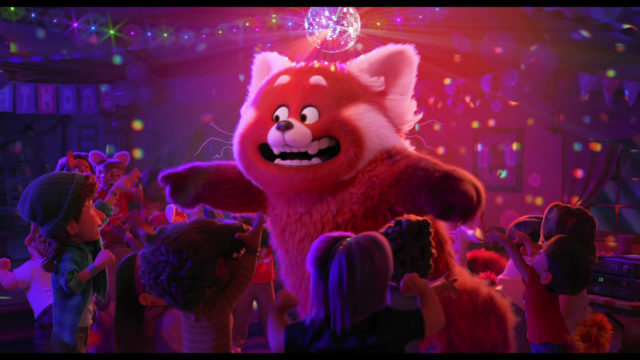By Luke Araujo | Staff Writer
*Spoiler alert: This review reveals details of plot points within the film*
“Turning Red,” an animated film directed by Domee Shi, premiered in theaters and on Disney+ Feb. 21. “Turning Red” is a flawed yet heartfelt movie offering an experience that could only be provided in the medium it was presented in.
Set in the streets of 2002 Toronto, the scenery oozes with color and style, making Meilin feel like a small piece of a massive world as she leaps across rooftops and city streets. On top of that, the dialogue delivered by its cast has a certain intangible energy to it, which fits snugly in a movie about kids going through one of the most emotional points in their lives. The dialogue is supported by expressive character animations and designs, each of which matches the characters’ eccentric personalities.
One of the best aspects of the film is the dynamics of the Lee family, as it’s both relatable and ripe with comedic opportunities. The movie provides Asian representation in a respectful and accurate way, which is undoubtedly a great step to take in an industry dominated by cliches.
Despite the movie’s strengths, I have one issue with how it handles the climax. After deciding to keep the power of the red panda, Meilin leaves her family home to attend the 4*Town concert. Meilin’s mother, Ming Lee, gives chase in her own red panda form. As she makes her way toward the concert stadium, she wreaks havoc across the city of Toronto.
Eventually, Ming arrives at the stadium and destroys the entire structure in no time. This scenario sent a poor message because it paints Ming as a mother willing to put the lives of others at risk for her own motherly desires. Furthermore, it failed to capture the more personal conflict between a mother and her daughter that the movie had done so well encapsulating up to this point.
While I understand the movie’s primary intent is to provide spectacle and action, it nonetheless made me feel as though there was another way a mother’s rage could be portrayed without making it feel like it must include the potential harm of innocent civilians.
Outside issues with the final act, “Turning Red” is a fantastic movie to watch individually or with family. The audio-visual experience it provides is a testament to the continual evolution of the animated field of film, and it proves that cinephiles should look forward to the solidification of animation as a true work of cinema.



